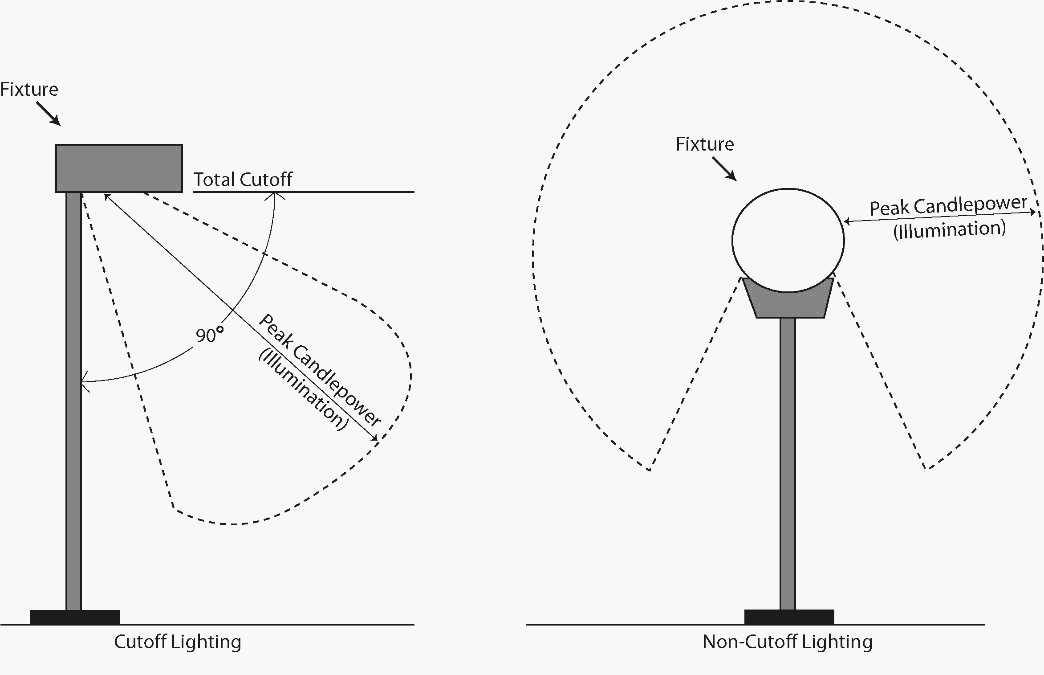(a) Photometric Plan.
(1) An outdoor lighting plan, including a photometric plan, shall be required for the installation or modification of exterior lights for any project requiring site plan review to ensure compliance with the requirements of this section. See Section 1165.06 Site Plan Review.
(2) The applicant must provide a plan that identifies the location, height, and type of luminaires, and shows how the applicant intends to comply with this section.
(b) Outdoor Lighting Standards.
(1) General Standards.
A. The placement of light poles within raised curb planting areas or landscaped islands is encouraged, provided that conflicts with landscaping trees that can obscure the lighting are avoided through the use of alternative lighting locations.
B. All wiring, fittings, and materials used in the construction, connection, and operation of electrically illuminated signs shall be in accordance with the provisions of the national electrical code in effect.
C. Outdoor lighting shall not be designed or located in such a way as to shine directly into an adjacent dwelling unit, regardless of the applicable zoning district.
D. In all nonresidential districts, all light fixtures within 20 feet of an adjacent residential lot shall be a full cutoff light fixture. See Figure 1173.03-1 for an illustration of cutoff and non-cutoff fixtures.
 |
Figure 1173.03 1: Cutoff and non-cutoff lighting
E. All outdoor lighting for nonresidential uses shall be located, screened, or shielded so that adjacent lots or streets located in residential districts are not directly illuminated.
F. No outdoor lighting shall be of such an intensity or color distortion as to cause glare or to impair the vision of drivers or pedestrians.
G. Exterior lighting, both building lighting and site lighting, shall minimize the impact of ambient light on the surrounding community.
(2) Height of Lighting.
A. The maximum height of a light fixture, either mounted on a pole or on a structure, is established in Table 1173.03-1: Maximum Height of a Light Fixture.
B. In no case shall a light fixture mounted on a structure be mounted at a height where the fixture will exceed the height of the roof line.
C. The base of the light fixture shall be included when measuring fixture height.
D. Wall pack fixtures on buildings are permitted but shall be restricted to cutoff fixture types to direct the light vertically downward.
TABLE 1173.03-1: MAXIMUM HEIGHT OF A LIGHT FIXTURE | ||
DISTRICT | MAXIMUM NUMBER OF NON-CUTOFF LIGHTING | MAXIMUM HEIGHT OF 90 DEGREE CUTOFF LIGHTING |
All Residential Zoning Districts | 8 feet | 12 feet [1] |
All Nonresidential Zoning Districts | 16 feet | 30 feet |
NOTES: [1] When the bulb, lamp, or light source is completely recessed and/or shielded from view by an observer at five feet above grade, the maximum height may be increased to 15 feet. | ||
(c) Illumination Standards. The maximum illumination permitted at the property line in each district type, as demonstrated by a photometric drawing, shall be as established in Table 1173.03-2: Maximum Illumination Level at the Property Line.
TABLE 1173.03-2: MAXIMUM ILLUMINATION LEVEL AT THE PROPERTY LINE | |
ADJACENT DISTRICT | MAXIMUM ILLUMINATION AT THE PROPERTY LINE (AVERAGE FOOTCANDLES) |
All Residential Zoning Districts | 0.5 |
All Business or Industrial Districts | 0.5 when adjacent to a residential use or 2.5 when adjacent to a lot in a nonresidential district |
(d) Building Ornamentation and Accentuation. Utilization of lighting to accentuate key architectural elements of a building or development is permitted.
(1) In no case shall such lighting flash or blink intermittently.
(2) Any such lighting source located on the side of a building that faces an adjoining residential use or zoning district shall be effectively screened from view of the residential use or zoning district.
(e) Nonconforming Outdoor Lighting.
(1) The nonconforming use of lighting may continue until the luminaire (total fixture, not just the bulb) is replaced, at which point, the lighting shall be subject to all standards of this subsection with the exception of maximum height.
(2) When a nonconforming lighting fixture, including the pole or support, is removed, the lighting fixture shall lose its legal nonconforming status and all new lighting shall be subject to all standards of this section.
(Ord. 7675. Passed 11-11-14.)